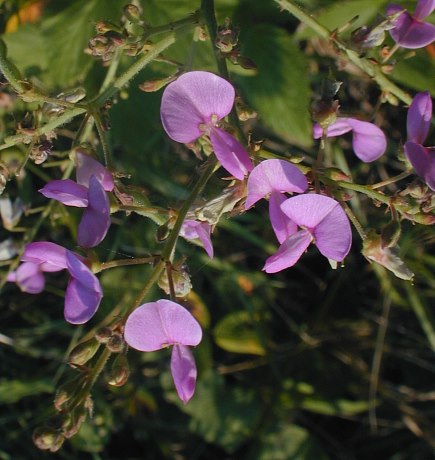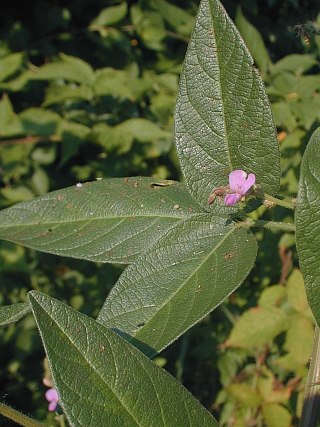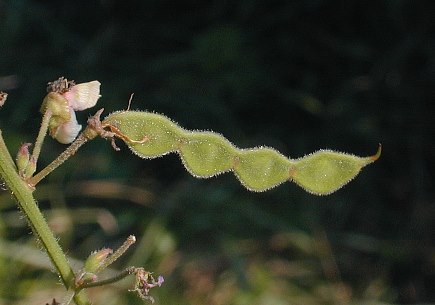Description: This perennial plant is about 2½–5' tall, branching occasionally and more or less erect. The stems are variably hairy, sometimes having hairs that occur in lines along their length. These hairs are white and either straight or somewhat curved, but not conspicuously hooked. The compound leaves alternate along the stems; they are trifoliate. The petioles of the compound leaves are about ½–1½" in length. At the base of each petiole is a pair of inconspicuous stipules that are deciduous and at least 5 times longer than they are wide. The leaflets are about 1½–3½" long and about half as much across. They are ovate-lanceolate or ovate and have smooth margins. The base of each leaflet is quite rounded. The upper surface of each leaflet is green or dark green, and nearly glabrous or finely pubescent. The lower surface is light green and faintly reticulate. There are usually fine hairs on the lower leaf surface, especially along the major veins, but the amount is variable.

The upper stems
terminate in panicles of light pink to purplish pink flowers. The
larger panicles can be 1-2' long and have spreading stems that produce
numerous flowers. Each flower is about ¼" long. These flowers have a
typical structure for members of the Bean family, consisting of a hood
and projecting keel. Near the center of each flower is a patch of white
that is surrounded by a thin line of purple. The blooming period can
occur from mid-summer to early fall, and lasts about a month. There is
no floral scent. Each fertilized flower is replaced by a flat loment (a
type of seedpod) consisting of 2-5 rounded segments. These loments are
about ¾–1½" long and covered with clinging hairs. The root system
consists of a taproot and nodule-forming secondary roots. This plant
spreads by reseeding itself.
Cultivation:
The preference is partial sun and mesic to slightly dry conditions.
This plant usually grows in soil that contains loam, clay-loam, or some
kind of rocky material. It does not appear to be affected by powdery
mildew to the same extent as Desmodium canadense
(Showy Tick Trefoil). Nitrogen is added to the soil through the root
nodules.

Range &
Habitat:
Perplexing Tick Trefoil occurs occasionally in the majority of counties
in Illinois; this native plant is a little more common in the southern
half of the
state than in the northern half (see Distribution
Map). The map doesn't distinguish between the distribution of
Desmodium
perplexum and Desmodium glabellum.
Habitats include savannas, rocky upland forests, edges of wooded areas,
thickets, and limestone glades.
Faunal
Associations: Like other Desmodium
spp., long-tongued bees are the primary pollinators of the
flowers.
Typical visitors include bumblebees, long-horned bees (Melissodes spp.),
and leaf-cutting
bees (Megachile spp.).
These insects collect pollen. The caterpillars of the skippers, Thorybes
pylades (Northern Cloudywing) and Thorybes bathyllus
(Southern Cloudywing), feed on the foliage. The seeds are eaten by some
upland gamebirds and small rodents, including the Bobwhite, Wild
Turkey, and White-footed Mouse. Mammalian herbivores eat Tick Trefoils
readily, including deer, rabbits, groundhogs, and livestock. These
mammals help to distribute the seeds as the loments readily cling to
their fur. The loments also cling to the clothing of humans.
Photographic Location:
The edge of a wooded area
in Judge Webber Park, Urbana, Illinois.

Comments: This Tick Trefoil species can produce large panicles of small flowers that are rather showy. It is one of the Desmodium spp. that blooms later in the year than many others. Unfortunately, it has been re-classified by taxonomists on several occasions, which may be the reason for the 'perplexum' in its scientific name. In some older sources of information, this plant is referred to as Desmodium dillenii and Desmodium glabellum. However, Desmodium glabellum is now considered a separate species with an appearance that is quite similar to Perplexing Tick Trefoil, while Desmodium dillenii is considered a defunct classification. Presumably, Desmodium perplexum and Desmodium glabellum can be distinguished as follows: 1) the former species has a faint reticulated network of veins on the lower surface of the leaflets, while the latter has a strong reticulated network of veins, and 2) the former species has hairs on the stems and leaves that are straight or somewhat curved, while the latter has hooked hairs. Other distinguishing features for Perplexing Tick Trefoil include inconspicuous stipules that are very narrow and deciduous (i.e., they wither away quickly), and petioles of the compound leaves that are at least ½" in length.